If you’re not free to walk around Central district in Hong Kong yourselves, feel free to take a look at the following as we show you some of the best of the 2018 edition of the HKWalls project.
Category: Hong Kong Street Arts
Audio Story
To listen to what some of the involved artists from HKWalls 2018 has to say, feel free to click play below:
Street Art Festival Making Art Affordable for The Public
Reported by Katherine Li, Tomiris Urstembayeva
Edited by Angie Chan, James Allen
Ever since the first week of April, those who pass through Central District often encounter some unexpected surprises when they take turns on familiar street corners or walk into shops they have not seen in a while. In some cases, that surprise can smile down at you from a 20 foot tall wall.
“I like to paint pictures of people smiling and laughing, because for the first time I felt actual interaction with the audience. People of all ages passing by are suddenly all looking at me and smiling.” says Elsa Jean de Dieu; a French wall artist who has been in Hong Kong for ten years, as she climbed down from tall scaffoldings and wiped the paint off her hands.

Enjoying capturing smiles and laughs of others, Jean De Dieu feels a connection with her audience through her mural arts.
Dieu is one of the many artists who participated in the 2018 HKWalls Festival, creating more than 28 murals and wall paintings across areas of Central and Sheung Wan over the time span of a week, attracting curious passersby with their artistry. This is her first year with HKwalls, even though this festival has been around for the past five years.
“Wall art is challenging in a way that we don’t have much time to do it. It’s not like a painting on canvas when you can do it for one month or two month. It’s also challenging because of the height, and because there are so many people looking at you at the beginning,”
Further challenges involved in completing her piece include bamboo scaffolding that is notoriously unstable, tiles that are near impossible to make a draft on, and protection measures that would impede her work if she adopted them.
“I enjoy this much more than painting on canvas, however,” said Dieu, gesturing to her half completed piece with the cap and facial features already intact. “The idea behind this new collection of happy people is to remind others to slow down, take a break, and to look at the smiles of others and maybe give them a smile too.”
According to Dieu, none of the artists are paid to participate in the event. This is a quest that relies on the artists giving time and energy for their passion and their desire to reach out to a larger audience.
Angela Ho, a local illustrator and a second year participant in HKwalls believes that this event can bring new life to many old neighbourhoods. She first became aware of HKwalls when it held a festival in Sheung Wan.

Illustrator Angel Ho working on her art piece signifying growth on Wellington Street.
“I liked the way they operate and attract people by art. What they’re trying to do to Hong Kong is to bring another dimension to the art that is less commercial, and I respect that. I think that it takes a lot of energy and a lot of effort to achieve this in a city like Hong Kong.” said Ho.
This year, drawing inspiration from pop-surrealism and graphic novels, Ho spent days painting the wall near to MANA!; a vegetarian restaurant on Wellington Street.
“This artwork portrays a seed that is growing. And I like that with design and artwork there wasn’t just one answer to a problem and also because the theme I was looking at is growth and new beginning,” explained Ho.
Fiona Kennedy-Aloft, award-winning Australian artist and also head of visual arts at Hong Kong Discovery College, believes that wall art does not just beautify an area, but can also educate the public and create tourism, especially in this age of social media when beautiful pictures of wall art can easily attract attention on Instagram. Examples of cities that have done that includes Melbourne and Berlin.
“It appeals to the majority as they don’t have to go to a gallery where they might feel uncomfortable or feel the need to buy,” said Aloft. “Take the sculptures in Hong Kong at the moment in the park, people didn’t set out to see art particularly on that day but they were exposed to it regardless. It might educated them about an issue, it might expose them to something they haven’t seen before and it makes the space more interesting.”
However, Aloft recognised that the difficulty of street art goes beyond the creation level.
“People seeing them as vandalising a space rather than it being artwork,” said Aloft, “Many are also using illegal spaces, are being caught doing so, and also using materials at their own expense for something that can’t be sold.”
According to her, renowned street artists such as Banksy and Anthony Lister both had their works destroyed, painted over or demolished several times. It is in their expectation for their work to be ephemeral, but some were simply removed too quickly.
Aloft believes that projects like HKwalls positively influence the local art scene, and expects to see growth in the number of people willing to give artists permission or to commission artists to paint on their shop fronts in laneways and industrial areas.
“Hong Kong is a very commercial art scene. We need more artist run spaces, I think that HKwalls and the new M+ art mall will improve public art and give artists more opportunities to do art for art’s sake rather than create art to sell,” said Aloft ultimately.














